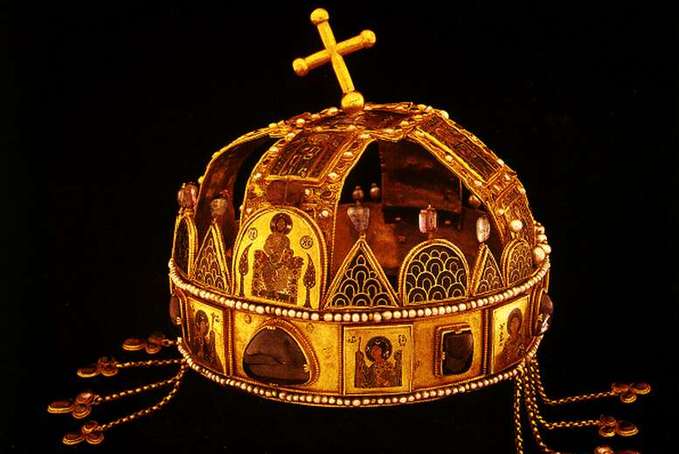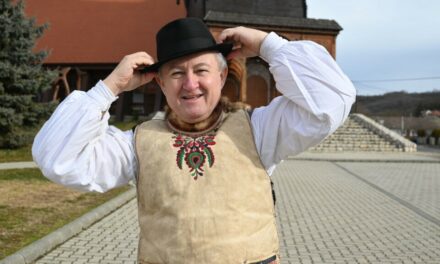József Bölöny, who died in 1990, speaks succinctly and expertly about the crown's actions during and after the war.
The public lawyer and historian successfully expressed his views on the history of the Holy Crown and - especially - the history of the doctrine of the Holy Crown on several occasions, even between the two world wars, when he argued in public law issues with a legitimist approach and strict respect for the facts. We quote him with the excerpt of his article published in 1978, which he published in the Historical Review with the intention of correcting the reports and other writings published on the return of the Holy Crown on January 5, 1978:
"The last migration of the crown and coronation insignia
Before his most recent absence, sacrilegious hands used the crown to attempt to legalize the Arrow coup and make the comedy of the swearing-in of the "leader of the nation" solemn. Antal Radvánszky reports on the related role of the crown and the crown guards
Albert Radvánszky recorded the following about the events of November 4, 1944: " Perényi (the other crown guard) brings the crown up to the castle (in the marble room) and after the official ceremony ( Szálas' oath-taking) they put it back in the iron box" to its place of custody, the castle cellar. Coroner Radvánszky added the following comment in parenthesis: "From October 25 to November 6, Albert Radvánszky was in the hospital with appendix irritation and did not participate in anything." Radvánszky diplomatically reported sick because he did not want to be present at Szálasi's oath of office, who insisted that he take the oath on the Holy Crown.
Crown guard Perényi, on the other hand, took the position (Albert Radvánszky mentioned this to me - continues Antal Radvánszky - during a conversation in the summer of 1948) that Szálasi could definitely take control of the crown, since the crown was no longer in the sealed vault, but only in the iron chest , whose original key was in the prime minister's office. Therefore, he did not want to leave the crown and the priority given to the resolution to accompany it to the oath. It would be futile to argue whether Szálasi would have risked bringing the crown from the castle cellar to the marble hall of the royal palace even then (November 4, 1944) without the assistance of a crown guard.
It is not without interest that both crown guards were members of the presidency of the upper house - Perényi as president, Radvánszky as first vice president - which resigned in protest on November 3, the day before the swearing-in, so that on the day of the swearing-in the upper house was led only by the president it could work.
When and under what circumstances did the crown, and among the insignia, the scepter, the apple of the throne and the coronation sword, leave the country for the longest and farthest journey in our history?
The most authentic answer to this question is also provided by the notes and oral communications of the last Crown Guard, Baron Albert Radvánszky, who died in Budapest in 1963. Miklós Komjáthy gives an outline of the former on the basis of a typed copy made on December 20, 1945 in the National Archives (Élet és Tudomány, Jan. 6, 1978). Likewise, the nephew of the late crown guard, Antal Radvánszky, is currently - according to his communication - the National In archive P 56675, fasc. Regarding the notes placed under number 4, based on a handwritten extract made by the crown guard while he was still alive and on the basis of his uncle's personal communication (date m.)
On November 6, the crown guard records that the crown guard took the crown to the shelter of the Magyar Nemzeti Bank in Veszprém. This was done with the agreement of the Crown Guards and the Szálasi government. The iron chest was sealed by the Crown Guards before being handed over to the Commander of the Crown Guards for removal. In mid-November, at the instigation of the crown guards, the coronation mantle was taken to the Benedictine archabbey in Pannonhalm and handed over to archabbot Kelemen Chrysostom (The cloak stretched out in its case under glass was kept hanging on the wall in Pannonhalma behind a heavy curtain.) Deputy Prime Minister Szőllősi The crown guards used this opportunity to emphatically inform him of their wish to transfer the holy crown and other coronation insignia to Pannonhalma.
József Mindszenty of Veszprém strongly supported their wish and handed Szőllősi the letter of Cardinal-Primate Serédi addressed to him on this subject. The crown guards deduced from Szőllősi's remark that the Arrow Cross government opposed the preservation of the crown in Pannonhalm due to the legitimist attitude of the Catholic high clergy. The crown guards wanted to get this solution accepted by the government because the main monastery was under the protection of the International Red Cross and they, the crown guards, true to their oath "wanted to keep the crown for the country". The developments fully justified the correctness of the position of the Crown Guards.
On December 6, the Arrow Cross government already 1715: XXXVIII. based on the section of the law referring to "in case of imminent danger or necessity", he took the holy crown to Kőszeg, located near the Austrian border, without the knowledge and consent of the crown guards. It is worth mentioning that even the de facto government of the Arrow Crusaders placed importance on preserving at least the appearance of legitimacy in this act, which is why they subsequently notified the crown guards in writing, who received this on December 8. The very next day, they left by car for Kőszeg after the crown. On the way, they stopped in Sopron, where the Szálasi government was staying at the time, to try again to persuade the government to take the crown to Pannonhalma. The government refused this and "under the burden of using its power tools prevented the crown guards from continuing their journey". However, they were verbally promised by Deputy Prime Minister Szőllősi to bury the crown in Kőszeg; however, despite their repeated urgings, he did not give a written communication about this. Thus, it was only in the spring of 1945 that the crown guards found out that the crown had been taken abroad.
As a somewhat grotesque example of the mystical power of the holy crown, Antal Radvánszky mentions in this context the widely unknown fact that "Foreign Minister" Szálasi from the American occupation zone of Austria sent a "list" to the American State Department in the beginning of June or the end of May 1945 on behalf of the refugee government. proposed that the fate of Hungary be negotiated with the exiled Szálasi government, because it exercises full state sovereignty even "in exile" because it still holds the crown of St. Stephen. Mr. Tyler laughingly showed him this writing , who until 1938 was the People's League Financial Commissioner in Hungary and to whom, as an expert on Hungarian affairs, it was given to him by the occupying authorities in Austria and the USA.
Csaba Zsiday provides a summary overview of the further fate of the crown and coronation badges in his article Buda to Augsburg (Hungary, Jan. 8, 1978). Ernő Pajtás , who escorted the crown until they were captured by the Americans, and who, according to his opinion, was already 8, later melted down to 6, József Bunda , who according to his statement was taken on December 11 in a tarpaulin truck from Veszprém to Kőszeg, also speaks ; On the 18th, they crossed the Austrian border and went to the village of Mattsee near Salzburg. Here, due to the violent action of the archers and the approach of the front, they decided to bury the crown and insignia, which happened on May 5 on the shore of the lake. According to the memoirs of the former head of the Augsburg interrogation group, the Americans searched for the buried crown, "the inside, the lining of which - the fabric part - was already completely rotten, and had to be taken out".
It should be noted that the crown was not damaged in any way, because before each coronation, a lining corresponding to the dimensions of the head of the king to be crowned was made. The circumference of the crown is 72 cm, so it exceeds the size of a man's head by about 10-20 centimeters. The cap-like, special lining, the so-called cap, made for the last two coronations in 1867 and 1916 by the owner of the Pórfi hat shop in Váci Street. The ruined and removed lining was therefore only made for the coronation in 1916.
The commander of the 7th Army allowed Colonel Pajtás, the commander of the Crown Guard, to accompany the crown when it was transported to Frankfurt. On August 22, 1956, Actio Catholica placed a memorial plaque with Hungarian-German inscriptions on the parish wall in Mattsee with the following text: »The Hungarian Holy Crown was kept here in 1945«. .
A symbolic episode of the fate of the Holy Crown is the list handed over by the Czechoslovak government to the Great Powers on April 10, 1946, in which the recognition of the immutability of the Trianon border, the resettlement of Hungarians from Czechoslovakia, the transfer of the Bratislava bridgehead and - as an unspoken guarantee - "the crown of Saint Stephen , the symbol of revisionism", demands that it be placed in the United Nations Museum. The humiliation of the Hungarian nation was thus connected with the attempt to humiliate the Holy Crown. Anyone who wants to put chains on the Hungarian nation is taking the crown captive!












